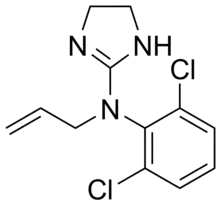 | |
| Clinical data | |
|---|---|
| ATC code |
|
| Legal status | |
| Legal status |
|
| Identifiers | |
| |
| CAS Number | |
| PubChem CID | |
| ChemSpider |
|
| UNII | |
| ChEMBL | |
| CompTox Dashboard (EPA) | |
| ECHA InfoCard | 100.164.275 |
| Chemical and physical data | |
| Formula | C12H13Cl2N3 |
| Molar mass | 270.16 g·mol−1 |
| 3D model (JSmol) | |
| |
| |
| | |
Alinidine (ST567) is a negative chronotrope that was developed in the 1970s and 1980s. It causes bradycardia by inhibiting the pacemaker current by altering the maximal channel conductance and alter the voltage threshold.[1] The development of alinidine was halted because it was not sufficiently specific for its target. It also has a blocking effect on calcium channels and potassium channels. It also causes elongation of re-polarisation after an action potential.[2]
Alinidine did not improve outcomes among patients with acute myocardial infarction in a randomized controlled trial.[3]
References
- ↑ Snyders DJ, Van Bogaert P-P: Alinidine modifies the pacemaker current in sheep Purkinje fibers. Pflügers Arch 1987, 410:83-91
- ↑ Current Opinion in Pharmacology 2007, 7:208–213
- ↑ Van de Werf F, Janssens L, Brzostek T, Mortelmans L, Wackers FJ, Willems GM, et al. (1993). "Short-term effects of early intravenous treatment with a beta-adrenergic blocking agent or a specific bradycardiac agent in patients with acute myocardial infarction receiving thrombolytic therapy". J Am Coll Cardiol. 22 (2): 407–16. doi:10.1016/0735-1097(93)90044-2. PMID 8335810.
| Sympatholytics (antagonize α-adrenergic vasoconstriction) | |||||
|---|---|---|---|---|---|
| Other antagonists |
| ||||
| |||||
| Calcium |
| ||||||||||||||||||||||||
|---|---|---|---|---|---|---|---|---|---|---|---|---|---|---|---|---|---|---|---|---|---|---|---|---|---|
| Potassium |
| ||||||||||||||||||||||||
| Sodium |
| ||||||||||||||||||||||||
| Chloride |
| ||||||||||||||||||||||||
| Others |
| ||||||||||||||||||||||||
See also: Receptor/signaling modulators • Transient receptor potential channel modulators | |||||||||||||||||||||||||
| Calcium |
| ||||||||||||||||||||||||
|---|---|---|---|---|---|---|---|---|---|---|---|---|---|---|---|---|---|---|---|---|---|---|---|---|---|
| Potassium |
| ||||||||||||||||||||||||
| Sodium |
| ||||||||||||||||||||||||
| Chloride |
| ||||||||||||||||||||||||
| Others |
| ||||||||||||||||||||||||
See also: Receptor/signaling modulators • Transient receptor potential channel modulators | |||||||||||||||||||||||||
This article is issued from Wikipedia. The text is licensed under Creative Commons - Attribution - Sharealike. Additional terms may apply for the media files.